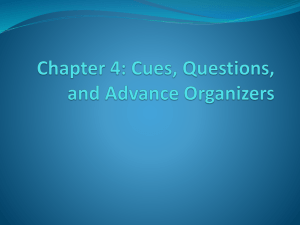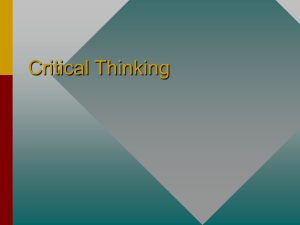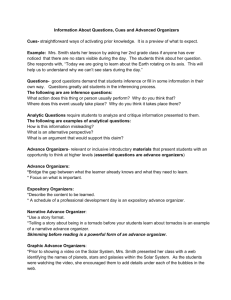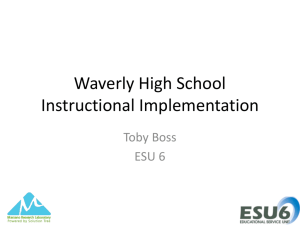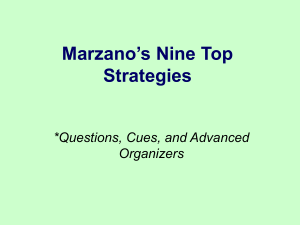Mitzi's ppt - ESU4InstructionalStrategies
advertisement
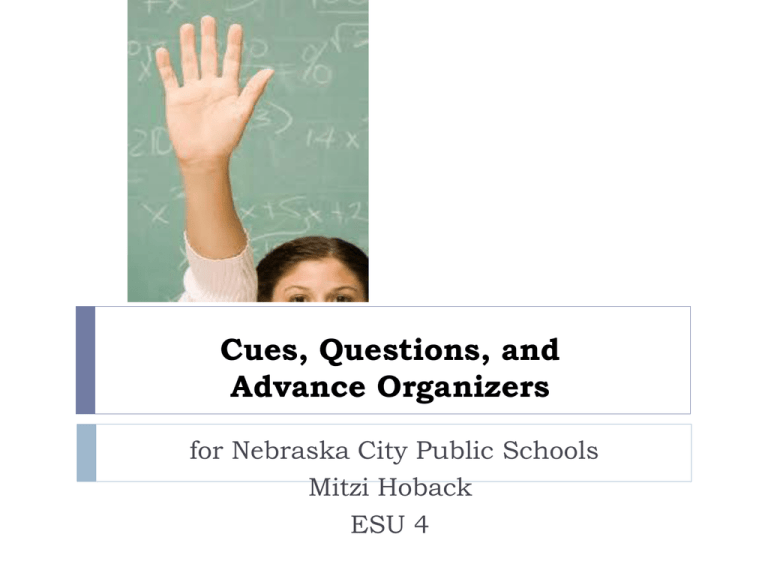
Cues, Questions, and Advance Organizers for Nebraska City Public Schools Mitzi Hoback ESU 4 How many questions do teachers ask? What’s in your toolbox? Goals for our session . . . Revisit your teacher’s toolbox Review Marzano’s Instructional Strategies Cues, Questions Explore and Advance Organizers ways to weave technology into the instructional strategies ESU 4 Instructional Strategies Wiki http://esu4instructionalstrategies.wikispaces.com “The illiterate of the 21st century will not be those who cannot read and write, but those who cannot learn, unlearn, and relearn.” Alvin Toffler 2001 An American writer and futurist Ave. Effect Size Percentile gain Identifying similarities and differences 1.61 45 Summarizing and note taking 1.00 34 Reinforcing effort and providing recognition .80 29 Homework and Practice .77 28 Nonlinguistic representations .75 27 Cooperative learning .73 27 Setting objectives/providing feedback .61 23 Generating and testing hypotheses .61 23 Questions, cues, and advance organizers .59 22 Category “The most important single factor influencing learning is what the learner already knows. Ascertain this and teach him accordingly” David Ausubel Previewing Any activity that starts students thinking about the content they will encounter Helps students activate prior knowledge Particularly useful for students who don’t have a lot of background knowledge about the topic The activation of prior knowledge is critical to learning because it helps students understand new information, predict what might be coming, and clarify misconceptions. “Educational researchers have shown that the activation of prior knowledge is critical to learning of all types.” ~ (Marzano, 2001, 2007) Previewing Cues Questions Advance Organizers The research on using advance organizers is significant. 3 to 29 percentile gain. The research on using cues is also significant. 3 to 32 percentile gain How do you use cues in your classroom? Video Clip Photos Brief Teacher Summary Hints Quick Draw Skimming Preview Questions Technology Tools for Cues Videos BrainPop http://www.brainpop.com/educators/home/ Watch Know Learn http://www.watchknowlearn.org/ Khan Academy http://www.khanacademy.org/ National Geographic Education http://bit.ly/zBFHyP ThinkFinity http://www.thinkfinity.org/ YouTube www.youtube.com www.zamzar.com quietyoutube Photos Getty Images http://bit.ly/zME8dz Google Images http://bit.ly/xrcNHm Advance Organizer s Advance Organizers: graphic organizers presented in advance of the lesson Focus on what’s important in a visual manner Organize information Help students see relationships between ideas, patterns in the information where they exist Help students maneuver through text Enhance comprehension Aid in transfer of knowledge Getting ready to learn….. The film “A Country in Conflict” describes the conditions of the North and South prior to the Civil War and the events leading up to the Civil War. What do you already know about the Civil War? While watching the film. Think about: •What were the political, economic, and social conditions that existed in the South and North before the Civil War? •How did the differences between the North and South lead to war? •Could the differences have been resolved using another means other than war? What did you learn as a result of watching the film? Anticipation Guides Before reading: In the column labeled me, place a check next to any statement with which you agree. After reading: Compare your opinions on those statements with information contained in the text. ME Text _______ ________ 1. Before the building of the canal, ships traveled South to get from the Caribbean Sea to the Pacific Ocean. _______ ________ 2. The fastest way from the Caribbean to the Pacific was by plane. _______ ________ 3. The building of the canal continued the US policy of isolation. _______ ________ 4. The geographic conditions helped make the building of the canal easier. _______ ________ 5. A canal through Panama would benefit the US politically and economically. _______ ________ 6. Latin America welcomed US control of the Panama Canal. _______ ________ 7. The control of Latin America by the US required the US to send troops to protect its interests. See the wiki for examples of advance organizers and anticipation guides http://esu4instructionalstrategies.wikispaces.com Questioning The Art of Questioning Great teachers are great questioners. Questioning is an everyday form of Instructional Feedback. Questioning is a great engagement tool. Questioning comes in many forms. Share Your Wisdom Work in groups of 3 or 4. Read each research-based statement about questioning. Discuss the implications for your classroom. Choose a facilitator for your group. Choose a reporter for your group. Every group member is a recorder! What are you currently doing in your classroom that addresses each statement? What additional strategies might you use? When time is called, the reporter should be prepared to summarize the conversation for each statement and share with the entire group. Teachers ask many questions. Most teacher questions are at the lowest cognitive level—known as fact, recall, or knowledge. Implications: Sattes,B. & Walsh, J., (2005). Quality questioning research-based practice to engage every learner. Teachers asked an average of 50.6 questions; students posed only 1.8 questions in a 30 minute period. Encouraging teachers to encourage children’s curiosity: A pivotal competence. Journal of Clinical Child Psychology, 8, 101-106. Teachers should plan their questions before asking. Teachers should ensure that questions match the instructional objectives and promote thinking. Teachers should purposefully plan and ask questions that require students to engage in higher level thinking. Not all students are accountable to respond to all questions. Implications: Teachers frequently call on volunteers, and these volunteers constitute a select group of students. Sattes,B. & Walsh, J., (2005). Quality questioning research-based practice to engage every learner. Teachers should establish classroom norms that every student deserves an opportunity to answer questions. All students’ answers are important. Every student responds every time! Make every classroom activity one in which all students respond to every question/activity/discussion. “Smile if you’re ready.” “Nod if you’re on page 16.” “Hold your pen up and wiggle it if you have your homewo .” “If you agree with me on this, raise one pinky.” “If this concept makes sense to you, give me a thumbs up.” “If you’re finished, turn your paper over.” “Hold up the handout if you have received one.” Richard Howell Allen, Impact Teaching, 2002 Try some procedures that get every child involved: Random Name Callers http://tinyurl.com/692tlxh Use Paired Responses (A/B partner response) Use choral responses Use hand signals (thumbs up/down) Use response systems Use playing cards Teachers typically wait less than one second after asking a question before calling on a student to answer. Implications: Teachers wait even less time before speaking after the student has answered. Sattes,B. & Walsh, J., (2005). Quality questioning research-based practice to engage every learner. Both wait times 1 and 2 promote student thinking and foster more students formulating answers to more questions. Teachers often accept incorrect answers without probing; they frequently answer their own questions. Implications: Sattes,B. & Walsh, J., (2005). Quality questioning researchbased practice to engage every learner. Teachers should seek to understand incorrect or incomplete answers more completely by gently guiding student thinking with appropriate probes. Probes for incomplete or incorrect…. 1. 2. 3. 4. Say more about that…. Give an example…. Tell me why you think that…. I might agree but I need more…. 30 In Summary… Before learning new information, teachers should help students retrieve what they already know about a topic or “activate prior knowledge.” Cues, questions and advance organizers are common ways that a classroom teacher helps students use what they already know about a topic to learn new information. Advance graphic organizers help students focus on important information by providing a mental set. Commitment: •Jot down one new thing you will try in your classroom as a result of today’s discussion. •Tell someone else what you plan to do.

